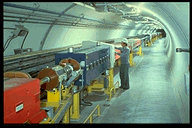

The Super Proton Synchrotron (SPS)

The Super Proton Synchrotron is a circular accelerator, 6 km in circumference,
buried underground. It was built originally to accelerate protons - and still
does so - but it has since operated as a proton-antiproton collider,
a heavy-ion accelerator, and an electron/positron injector for LEP.
As a proton-antiproton collider in the 1980s, it provided CERN with one
of its greatest moments - the first observations of the W and Z particles,
the carriers of the weak force.
The SPS can also accelerate lead ions to an energy of 170 GeV per nucleon,
with 208 nucleons in the lead nucleus. At present, this is the highest
energy obtained in the world, and it serves the study of the quark-gluon
plasma which may have occured shortly after the big bang.


